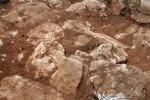Summary (English)
Tumulus 11 (20 × 18 m; h. 1) is a large and complex monument divided into two chambers, one funerary, the other ceremonial.The funerary chamber is formed by a space within a circular enclosure created through the careful placing of boulders and stones that were also used to create a floor surface. Here, at the base, was a vase containing burnt bones placed inside a crown of flat slabs inserted into a circle of blocks. The vase rested on a surface of baked clay and wooden elements.
On the north side of the enclosure there was a dry-stone construction in the form of a circular cist built of stone blocks, containing a vase and burnt human bones.The funerary chamber was distinct from the ceremonial space: it appears as a sort of arena bordered along its circular perimeter by an imposing dry-stone wall with a double curtain whose collapse was attested by the spread of small stones from the fill, visible along its line. At the centre was a 1 × 1 m hole containing abundant charcoal and some human bone.
The entire monument, built by exploiting the bedrock’s natural differences in height, appears as a megalithic construction able to transmit the idea of strength and power visible from a great distance.The importance of this find comes not only from the architectural type and variety of ceremonial activities attested within it, but also from the fact that it confirms the entire area to be an actual necropolis of tumuli, the only one known to date for the Eneolithic period in southern Italy.
Director
- Elettra Ingravallo – Dipartimento di Beni Culturali – Università del Salento
Team
- Giorgia Aprile, collaboratrice Laboratorio di Paletnologia – Dipartimento di Beni Culturali, Università del Salento
- Ida Tiberi, collaboratrice Laboratorio di Paletnologia – Dipartimento di Beni Culturali, Università del Salento
Research Body
- Dipartimento di Beni Culturali – Università del Salento






![Download [PDF]](/excavation/skins/fasti/images/results/download_sml.png)